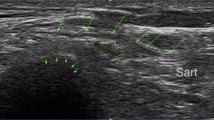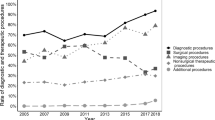Abstract
Background
Meralgia paresthetica is a mononeuropathy of the lateral femoral cutaneous nerve (LCFN). Surgical treatment involves transection or decompression of the LCFN. There is no clear consensus on the superiority of one technique over the other. We performed a systematic review of the literature to answer this question.
Methods
Eligible studies included those that compared neurolysis versus neurectomy for the treatment of meralgia paresthetica after failure of conservative therapy. Our outcome of interest was resolution of symptoms. We performed a computerized search of MEDLINE (PubMed; all years) and of the Cochrane Central Register of Controlled Trials. Eligible studies had to include the words “meralgia paresthetica” and “surgery.” All patients regardless of age were included, and there was no language restriction. We then reviewed the articles’ titles and abstracts. All studies that compared neurolysis to neurectomy were included in the analysis.
Results
Of the studies identified, none were randomized controlled trials. There were two German language articles that were translated by a third researcher.
Each study was evaluated by two independent researchers who assigned a level of evidence according to American Association of Neurologist algorithm and also performed data extraction (neurolysis vs. neurectomy and resolution of pain symptoms). Each study was found to be level four evidence.
Conclusion
After reviewing the data, there was insufficient evidence to recommended one method of treatment over the other. This highlights the importance of keeping a national registry in order to compare outcomes between the two methods of treatment.

Similar content being viewed by others
References
Ahmed A, Arora D, Kochhar AK (2016) Ultrasound-guided alcohol neurolysis of lateral femoral cutaneous nerve for intractable meralgia paresthetica: a case series. Br J Pain 10(4):232–237
Antoniadis G, Braun V, Rath S, Moese G, Richter HP (1995) Meralgia paraesthetica and its surgical treatment. Nervenarzt 66(8):614–7
Balshem H, Helfand M, Schünemann HJ et al (2011) GRADE guidelines: 3. Rating the quality of evidence. J Clin Epidemiol 64(4):401–406
Benezis I, Boutaud B, Leclerc J, Fabre T, Durandeau A (2007) Lateral femoral cutaneous neuropathy and its surgical treatment: a report of 167 cases. Muscle Nerve 36(5):659–663
Benini A (1992) Meralgia paresthetica. Pathogenesis, clinical aspects and therapy of compression of the lateral cutaneous nerve of the thigh. Schweiz Rundsch Med Prax 81(8):215–21
Berini SE, Spinner RJ, Jentoft ME, Engelstad JK, Staff NP, Suanprasert N, Dyck PJB, Klein CJ (2014) Chronic meralgia paresthetica and neurectomy: a clinical pathologic study. Neurology 82(17):1551–1555
Boyce JR (1984) Meralgia paresthetica and tight trousers. JAMA 251(12):1553
Cheatham SW, Kolber MJ, Salamh PA (2013) Meralgia paresthetica: a review of the literature. Int J Sports Phys Ther 8(6):883–93
De Ruiter GCW, Kloet A (2015) Comparison of effectiveness of different surgical treatments for meralgia paresthetica: results of a prospective observational study and protocol for a randomized controlled trial. Clin Neurol Neurosurg 134:7–11
De Ruiter GCW, Wurzer JAL, Kloet A (2012) Decision making in the surgical treatment of meralgia paresthetica: neurolysis versus neurectomy. Acta Neurochir (Wien) 154(10):1765–1772
Ducic I, Dellon AL, Taylor NS (2006) Decompression of the lateral femoral cutaneous nerve in the treatment of meralgia paresthetica. J Reconstr Microsurg 22(2):113–118
Emamhadi M (2012) Surgery for meralgia paresthetica: neurolysis versus nerve resection. Turk Neurosurg 22(6):758–762
Fowler IM, Tucker AA, Mendez RJ (2012) Treatment of meralgia paresthetica with ultrasound-guided pulsed radiofrequency ablation of the lateral femoral cutaneous nerve. Pain Pract 12(5):394–8
Haim A, Pritsch T, Ben-Galim P, Dekel S (2006) Meralgia paresthetica: a retrospective analysis of 79 patients evaluated and treated according to a standard algorithm. Acta Orthop 77(3):482–486
Hurdle MF, Weingarten TN, Crisostomo RA, Psimos C, Smith J (2007) Ultrasound-guided blockade of the lateral femoral cutaneous nerve: technical description and review of 10 cases. Arch Phys Med Rehabil 88(10):1362–1364
Khalil N, Nicotra A, Rakowicz W (2008) Treatment for meralgia paraesthetica. Cochrane Database Syst Rev. doi:10.1002/14651858.CD004159.pub2
Kim JE, Lee SG, Kim EJ, Min BW, Ban ong S, Lee JH (2011) Ultrasound-guided lateral femoral cutaneous nerve block in meralgia paresthetica. Korean J Pain 24(2):115–118
Lagueny A, Deliac MM, Deliac P, Durandeau A (1991) Diagnostic and prognostic value of electrophysiologic tests in meralgia paresthetica. Muscle Nerve 14(1):51–6
Lee FC (1941) An osteoplastic neurolysis operation for the cure of meralgia paresthetica. Ann Surg 113(1):85–94
Macnicol MF, Thompson WJ (1990) Idiopathic meralgia paresthetica. Clin Orthop Relat Res 270–274
Nahabedian MY, Dellon AL (1995) Meralgia paresthetica: etiology, diagnosis, and outcome of surgical decompression. Ann Plast Surg 35(6):590–4
Nouraei SAR, Anand B, Spink G, O’Neill KS (2007) A novel approach to the diagnosis and management of meralgia paresthetica. Neurosurgery 60(4):696–700
Onat SS, Ata AM, Ozcakar L (2016) Ultrasound-guided diagnosis and treatment of meralgia paresthetica. Pain Physician 19(4):E667–9
Parisi TJ, Mandrekar J, Dyck PJB, Klein CJ (2011) Meralgia paresthetica: relation to obesity, advanced age, and diabetes mellitus. Neurology 77(16):1538–1542
Rattananan W, Thaisetthawatkul P, Dyck PJB (2014) Postsurgical inflammatory neuropathy: a report of five cases. J Neurol Sci 337(1–2):137–40
Seror P, Seror R (2006) Meralgia paresthetica: clinical and electrophysiological diagnosis in 120 cases. Muscle Nerve 33(5):650–4
Sieg EP, Payne RA, Hazard S, Rizk E (2016) Evaluating the evidence: is phrenic nerve stimulation a safe and effective tool for decreasing ventilator dependence in patients with high cervical spinal cord injuries and central hypoventilation? Childs Nerv Syst 32(6):1033–1038
Siu TLT, Chandran KN (2005) Neurolysis for meralgia paresthetica: an operative series of 45 cases. Surg Neurol 63(1):19–23
Son B, Kim D-R, Kim I, Hong J, Sung J, Lee S (2012) Neurolysis for meralgia paresthetica. J Korean Neurosurg Soc 51(6):363–6
Stookey B (1928) Meralgia paraesthetica. JAMA 90(21):1705
Suh DH, Kim DH, Park JW, Park BK (2013) Sonographic and electrophysiologic findings in patients with meralgia paresthetica. Clin Neurophysiol 124(7):1460–1464
Tagliafico A, Serafini G, Lacelli F, Perrone N, Valsania V, Martinoli C (2011) Ultrasound-guided treatment of meralgia paresthetica (LFCN). J Ultrasound Med 1341–1346
Van Eerten PV, Polder TW, Broere CA (2015) Operative treatment of meralgia paresthetica: transection versus neurolysis. Neurosurgery 37(1):63–65
Williams PH, Trzil KP (1991) Management of meralgia paresthetica. J Neurosurg 74:76–80
Author information
Authors and Affiliations
Corresponding author
Ethics declarations
Conflict of interest
All authors certify that they have no affiliations with or involvement in any organization or entity with any financial interest (such as honoraria; educational grants; participation in speakers’ bureaus; membership, employment, consultancies, stock ownership, or other equity interest; and expert testimony or patent-licensing arrangements), or non-financial interest (such as personal or professional relationships, affiliations, knowledge or beliefs) in the subject matter or materials discussed in this manuscript.
Ethical approval
All procedures performed in studies involving human participants were in accordance with the ethical standards of the institutional and/or national research committee and with the 1964 Helsinki Declaration and its later amendments or comparable ethical standards.
This article does not contain any studies with human participants performed by any of the authors.
Additional information
Comments
The authors are to be commended on rigorously reviewing the literature for studies comparing the efficacy of decompression versus neurectomy of the lateral femoral cutaneous nerve in patients with a clinical diagnosis of merralgia paresthetica refractory to non-surgical therapies. It is humbling to realize that despite 131 years having elapsed since the first surgical procedure for this condition, we still have no definitive study comparing the two types of surgical procedure for this condition. The authors make the very good point that surgical registries should be kept so that such a comparison can be made going forward. Although not the major focus of this article, I wonder if the authors would like to comment on the potential downside of performing a neurectomy that results in long-lasting analgesia in the distribution of the lateral femoral cutaneous nerve, which can produce unpleasant paresthesias. The authors also mention steroid injections as both a treatment and diagnostic test but do not mention injections of local anesthetic to help in diagnosing this condition. The authors also might want to at least mention the growing ultrasound literature showing the ability to both help diagnose and surgically treat this condition by being able to preoperatively localize the nerve, which can sometimes be a challenge to find.
Michel Kliot
Illinois, USA
Rights and permissions
About this article
Cite this article
Payne, R., Seaman, S., Sieg, E. et al. Evaluating the evidence: is neurolysis or neurectomy a better treatment for meralgia paresthetica?. Acta Neurochir 159, 931–936 (2017). https://doi.org/10.1007/s00701-017-3136-x
Received:
Accepted:
Published:
Issue Date:
DOI: https://doi.org/10.1007/s00701-017-3136-x




